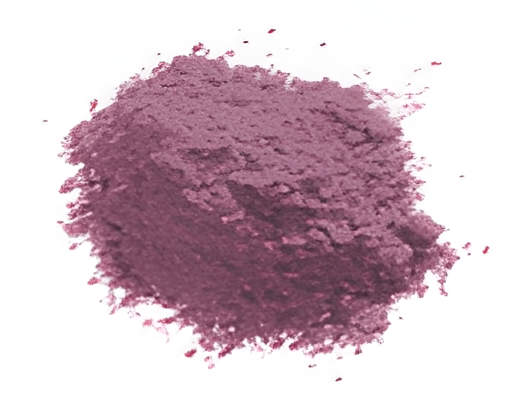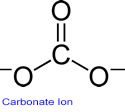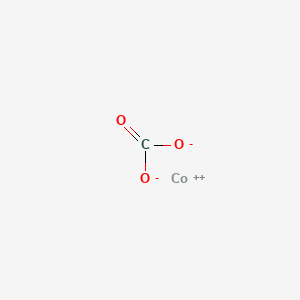SECTION 1. IDENTIFICATION
Product Name: Cobalt Carbonate
Product Number: All applicable American Elements product codes, e.g. CO-CB-02
, CO-CB-03
, CO-CB-04
, CO-CB-05
CAS #: 513-79-1
Relevant identified uses of the substance: Scientific research and development
Supplier details:
American Elements
10884 Weyburn Ave.
Los Angeles, CA 90024
Tel: +1 310-208-0551
Fax: +1 310-208-0351
Emergency telephone number:
Domestic, North America: +1 800-424-9300
International: +1 703-527-3887
SECTION 2. HAZARDS IDENTIFICATION
Classification of the substance or mixture in accordance with 29 CFR 1910 (OSHA HCS)
GHS08 Health hazard
Resp. Sens. 1 H334 May cause allergy or asthma symptoms or breathing difficulties if inhaled.
Muta. 2
H341 Suspected of causing genetic defects.
Carc. 1B
H350 May cause cancer.
Repr. 1A
H360 May damage fertility or the unborn child.
GHS07
Acute Tox. 4
H302 Harmful if swallowed.
Skin Sens. 1
H317 May cause an allergic skin reaction.
Hazards not otherwise classified
No information known.
Label elements
GHS label elements
The product is classified and labeled in accordance with 29 CFR 1910 (OSHA HCS)
Hazard pictograms


GHS07
GHS08
Signal word: Danger
Hazard statements
H302 Harmful if swallowed.
H334 May cause allergy or asthma symptoms or breathing difficulties if inhaled.
H317 May cause an allergic skin reaction.
H341 Suspected of causing genetic defects.
H350 May cause cancer.
H360 May damage fertility or the unborn child.
Precautionary statements
P284
In case of inadequate ventilation wear respiratory protection.
P261
Avoid breathing dust/fume/gas/mist/vapours/spray.
P280
Wear protective gloves/protective clothing/eye protection/face protection.
P342+P311 If experiencing respiratory symptoms: Call a POISON CENTER/doctor/...
P405
Store locked up.
P501
Dispose of contents/container in accordance with local/regional/national/international regulations.
WHMIS classification
D2A - Very toxic material causing other toxic effects
Classification system
HMIS ratings (scale 0-4)
(Hazardous Materials Identification System)
Health (acute effects) = 2
Flammability = 0
Physical Hazard = 1
Other hazards
Results of PBT and vPvB assessment
PBT: Not applicable.
vPvB: Not applicable.
SECTION 3. COMPOSITION/INFORMATION ON INGREDIENTS
Chemical characterization: Substances
CAS# Description:
513-79-1 Cobalt(II) carbonate
Identification number(s):
EC number: 208-169-4
Index number: 027-010-00-8
SECTION 4. FIRST AID MEASURES
Description of first aid measures
After inhalation
Supply fresh air. If required, provide artificial respiration. Keep patient warm.
Seek immediate medical advice.
After skin contact
Immediately wash with water and soap and rinse thoroughly.
Seek immediate medical advice.
After eye contact
Rinse opened eye for several minutes under running water. Then consult a doctor.
After swallowing
Seek medical treatment.
Information for doctor
Most important symptoms and effects, both acute and delayed
No further relevant information available.
Indication of any immediate medical attention and special treatment needed
No further relevant information available
SECTION 5. FIREFIGHTING MEASURES
Extinguishing media
Suitable extinguishing agents
Product is not flammable. Use fire-fighting measures that suit the surrounding fire.
Special hazards arising from the substance or mixture
If this product is involved in a fire, the following can be released:
Carbon monoxide and carbon dioxide
Cobalt oxides
Advice for firefighters
Protective equipment:
Wear self-contained respirator.
Wear fully protective impervious suit.
SECTION 6. ACCIDENTAL RELEASE MEASURES
Personal precautions, protective equipment and emergency procedures
Wear protective equipment. Keep unprotected persons away.
Ensure adequate ventilation
Environmental precautions:
Do not allow product to reach sewage system or any water course.
Methods and material for containment and cleaning up:
Dispose of contaminated material as waste according to section 13.
Ensure adequate ventilation.
Prevention of secondary hazards:
No special measures required.
Reference to other sections
See Section 7 for information on safe handling
See Section 8 for information on personal protection equipment.
See Section 13 for disposal information.
SECTION 7. HANDLING AND STORAGE
Handling
Precautions for safe handling
Keep container tightly sealed.
Store in cool, dry place in tightly closed containers.
Ensure good ventilation at the workplace.
Open and handle container with care.
Information about protection against explosions and fires:
The product is not flammable
Conditions for safe storage, including any incompatibilities
Storage
Requirements to be met by storerooms and receptacles:
No special requirements.
Information about storage in one common storage facility:
Do not store together with acids.
Store away from oxidizing agents.
Further information about storage conditions:
Keep container tightly sealed.
Store in cool, dry conditions in well sealed containers.
Specific end use(s)
No further relevant information available.
SECTION 8. EXPOSURE CONTROLS/PERSONAL PROTECTION
Additional information about design of technical systems:
Properly operating chemical fume hood designed for hazardous chemicals and having an average face velocity of at least 100 feet per minute.
Exposure controls
Personal protective equipment
General protective and hygienic measures
The usual precautionary measures for handling chemicals should be followed.
Keep away from foodstuffs, beverages and feed.
Remove all soiled and contaminated clothing immediately.
Wash hands before breaks and at the end of work.
Store protective clothing separately.
Maintain an ergonomically appropriate working environment.
Breathing equipment:
Use suitable respirator when high concentrations are present.
Protection of hands:
Impervious gloves
Check protective gloves prior to each use for their proper condition.
The selection of suitable gloves not only depends on the material, but also on quality. Quality will vary from manufacturer to manufacturer.
Penetration time of glove material (in minutes): Not determined
Eye protection: Safety glasses
Body protection: Protective work clothing.
SECTION 9. PHYSICAL AND CHEMICAL PROPERTIES
Information on basic physical and chemical properties
General Information
Appearance:
Form: Powder
Color: Pink
Odor: Odorless
Odor threshold: Not determined.
pH-value: Not applicable.
Change in condition
Melting point/Melting range: Decomposes
Boiling point/Boiling range: Not determined
Sublimation temperature / start: Not determined
Flammability (solid, gaseous): Not determined.
Ignition temperature: Not determined
Decomposition temperature: Not determined
Auto igniting: Not determined.
Danger of explosion: Not determined.
Explosion limits:
Lower: Not determined
Upper: Not determined
Vapor pressure: Not applicable.
Density at 20 °C (68 °F): 4.13 g/cm³ (34.465 lbs/gal)
Relative density: Not determined.
Vapor density: Not applicable.
Evaporation rate: Not applicable.
Solubility in / Miscibility with Water: Insoluble
Partition coefficient (n-octanol/water): Not determined.
Viscosity:
dynamic: Not applicable.
kinematic: Not applicable.
Other information
No further relevant information available.
SECTION 10. STABILITY AND REACTIVITY
Reactivity
No information known.
Chemical stability
Stable under recommended storage conditions.
Thermal decomposition / conditions to be avoided:
Decomposition will not occur if used and stored according to specifications.
Possibility of hazardous reactions
Reacts with strong oxidizing agents
Conditions to avoid
No further relevant information available.
Incompatible materials:
Acids
Oxidizing agents
Hazardous decomposition products:
Carbon monoxide and carbon dioxide
Cobalt oxides
SECTION 11. TOXICOLOGICAL INFORMATION
nformation on toxicological effects
Acute toxicity:
The Registry of Toxic Effects of Chemical Substances (RTECS) contains acute toxicity data for this substance.
LD/LC50 values that are relevant for classification:
Oral LD50 640 mg/kg (rat)
Skin irritation or corrosion: May cause irritation
Eye irritation or corrosion: May cause irritation
Sensitization:
May cause allergy or asthma symptoms or breathing difficulties if inhaled.
May cause an allergic skin reaction.
Germ cell mutagenicity:
Suspected of causing genetic defects.
Carcinogenicity:
May cause cancer.
IARC-2B: Possibly carcinogenic to humans: limited evidence in humans in the absence of sufficient evidence in experimental animals.
ACGIH A3: Animal carcinogen: Agent is carcinogenic in experimental animals at a relatively high dose, by route(s) of administration, at site(s), of histologic type(s), or by mechanism(s) not considered relevant to worker exposure. Available epidemologic studies do not confirm an increased risk of cancer in exposed humans.
Available evidence suggests that the agent is not likely to cause cancer in humans except under uncommon or unlikely routes or levels of exposure.
Reproductive toxicity:
May damage fertility or the unborn child.
Specific target organ system toxicity - repeated exposure:
No effects known.
Specific target organ system toxicity - single exposure:
No effects known.
Aspiration hazard:
No effects known.
Subacute to chronic toxicity:
No effects known.
Additional toxicological information:
To the best of our knowledge the acute and chronic toxicity of this substance is not fully known.
SECTION 12. ECOLOGICAL INFORMATION
Toxicity
Aquatic toxicity:
No further relevant information available.
Persistence and degradability
No further relevant information available.
Bioaccumulative potential
No further relevant information available.
Mobility in soil
No further relevant information available.
Ecotoxical effects:
Remark:
Very toxic for aquatic organisms
Additional ecological information:
General notes:
Do not allow product to reach ground water, water course or sewage system.
Danger to drinking water if even small quantities leak into the ground.
Also poisonous for fish and plankton in water bodies.
May cause long lasting harmful effects to aquatic life.
Avoid transfer into the environment.
Very toxic for aquatic organisms
Results of PBT and vPvB assessment
PBT: Not applicable.
vPvB: Not applicable.
Other adverse effects
No further relevant information available.
SECTION 13. DISPOSAL CONSIDERATIONS
Waste treatment methods
Recommendation
Consult state, local or national regulations to ensure proper disposal.
Uncleaned packagings:
Recommendation:
Disposal must be made according to official regulations
SECTION 14. TRANSPORT INFORMATION
UN-Number
DOT, IMDG, IATA
UN3077
UN proper shipping name
DOT
Environmentally hazardous substances, solid, n.o.s. (Cobalt(II) carbonate)
IMDG, IATA
ENVIRONMENTALLY HAZARDOUS SUBSTANCE, SOLID, N.O.S. (Cobalt(II) carbonate)
Transport hazard class(es)
DOT, IMDG
Class
9 Miscellaneous dangerous substances and articles.
Label
9
Class
9 (M7) Miscellaneous dangerous substances and articles
Label
9
IATA
Class
9 Miscellaneous dangerous substances and articles.
Label
9
Packing group
DOT, IMDG, IATA
III
Environmental hazards:
Special marking (ADR):
Symbol (fish and tree)
Special marking (IATA):
Symbol (fish and tree)
Special precautions for user
Warning: Miscellaneous dangerous substances and articles
EMS Number:
F-A,S-F
Transport in bulk according to Annex II of MARPOL73/78 and the IBC Code
Not applicable.
Transport/Additional information:
DOT
Marine Pollutant (DOT):
No
UN "Model Regulation":
UN3077, Environmentally hazardous substances, solid, n.o.s. (Cobalt(II) carbonate), 9, III
SECTION 15. REGULATORY INFORMATION
Safety, health and environmental regulations/legislation specific for the substance or mixture
GHS label elements The product is classified and labeled in accordance with 29 CFR 1910 (OSHA HCS)
Hazard pictograms
GHS07 GHS08
Signal word Danger
Hazard statements
H302 Harmful if swallowed.
H334 May cause allergy or asthma symptoms or breathing difficulties if inhaled.
H317 May cause an allergic skin reaction.
H341 Suspected of causing genetic defects.
H350 May cause cancer.
H360 May damage fertility or the unborn child.
Precautionary statements
P284 In case of inadequate ventilation wear respiratory protection.
P261 Avoid breathing dust/fume/gas/mist/vapours/spray.
P280 Wear protective gloves/protective clothing/eye protection/face protection.
P342+P311 If experiencing respiratory symptoms: Call a POISON CENTER/doctor/…
P405 Store locked up.
P501 Dispose of contents/container in accordance with local/regional/national/international regulations.
National regulations
All components of this product are listed in the U.S. Environmental Protection Agency Toxic Substances Control Act Chemical substance Inventory.
All components of this product are listed on the Canadian Domestic Substances List (DSL).
SARA Section 313 (specific toxic chemical listings)
513-79-1 Cobalt(II) carbonate
California Proposition 65
Prop 65 - Chemicals known to cause cancer Substance is not listed.
Prop 65 - Developmental toxicity Substance is not listed.
Prop 65 - Developmental toxicity, female Substance is not listed.
Prop 65 - Developmental toxicity, male Substance is not listed.
Information about limitation of use: For use only by technically qualified individuals.
Other regulations, limitations and prohibitive regulations
Substance of Very High Concern (SVHC) according to the REACH Regulations (EC) No. 1907/2006.
This substance is included in the Candidate List of Substances of Very High Concern (SVHC) according to Regulation (EC) No. 1907/2006 (REACH).
The conditions of restrictions according to Article 67 and Annex XVII of the Regulation (EC) No 1907/2006 (REACH) for the manufacturing, placing on the
market and use must be observed.
Substance is not listed.
Annex XIV of the REACH Regulations (requiring Authorisation for use) Substance is not listed.
Chemical safety assessment: A Chemical Safety Assessment has not been carried out.
SECTION 16. OTHER INFORMATION
Safety Data Sheet according to Regulation (EC) No. 1907/2006 (REACH). The above information is believed to be correct but does not purport to be all inclusive and shall be used only as a guide. The information in this document is based on the present state of our knowledge and is applicable to the product with regard to appropriate safety precautions. It does not represent any guarantee of the properties of the product. American Elements shall not be held liable for any damage resulting from handling or from contact with the above product. See reverse side of invoice or packing slip for additional terms and conditions of sale. COPYRIGHT 1997-2022 AMERICAN ELEMENTS. LICENSED GRANTED TO MAKE UNLIMITED PAPER COPIES FOR INTERNAL USE ONLY.


 The number of electrons in each of cobalt's shells is 2, 8, 15, 2 and its electron configuration is [Ar]3d7 4s2. The cobalt atom has a radius of 125 pm and a Van der Waals radius of 192 pm. Cobalt was first discovered by George Brandt in 1732. In its elemental form, cobalt has a lustrous gray appearance. Cobalt is found in cobaltite, erythrite, glaucodot and skutterudite ores.
The number of electrons in each of cobalt's shells is 2, 8, 15, 2 and its electron configuration is [Ar]3d7 4s2. The cobalt atom has a radius of 125 pm and a Van der Waals radius of 192 pm. Cobalt was first discovered by George Brandt in 1732. In its elemental form, cobalt has a lustrous gray appearance. Cobalt is found in cobaltite, erythrite, glaucodot and skutterudite ores.  Cobalt produces brilliant blue pigments which have been used since ancient times to color paint and glass. Cobalt is a ferromagnetic metal and is used primarily in the production of
Cobalt produces brilliant blue pigments which have been used since ancient times to color paint and glass. Cobalt is a ferromagnetic metal and is used primarily in the production of 
